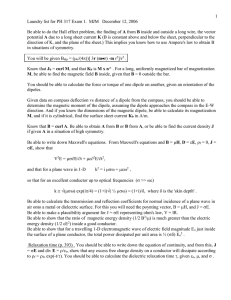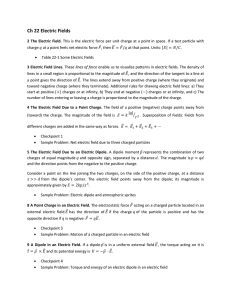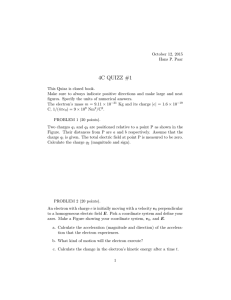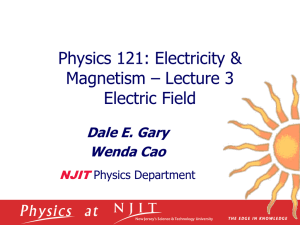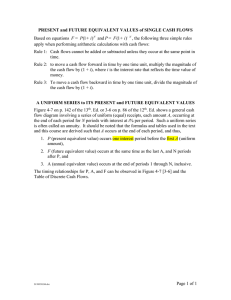PH2200 Practice Exam I Summer 2003
advertisement
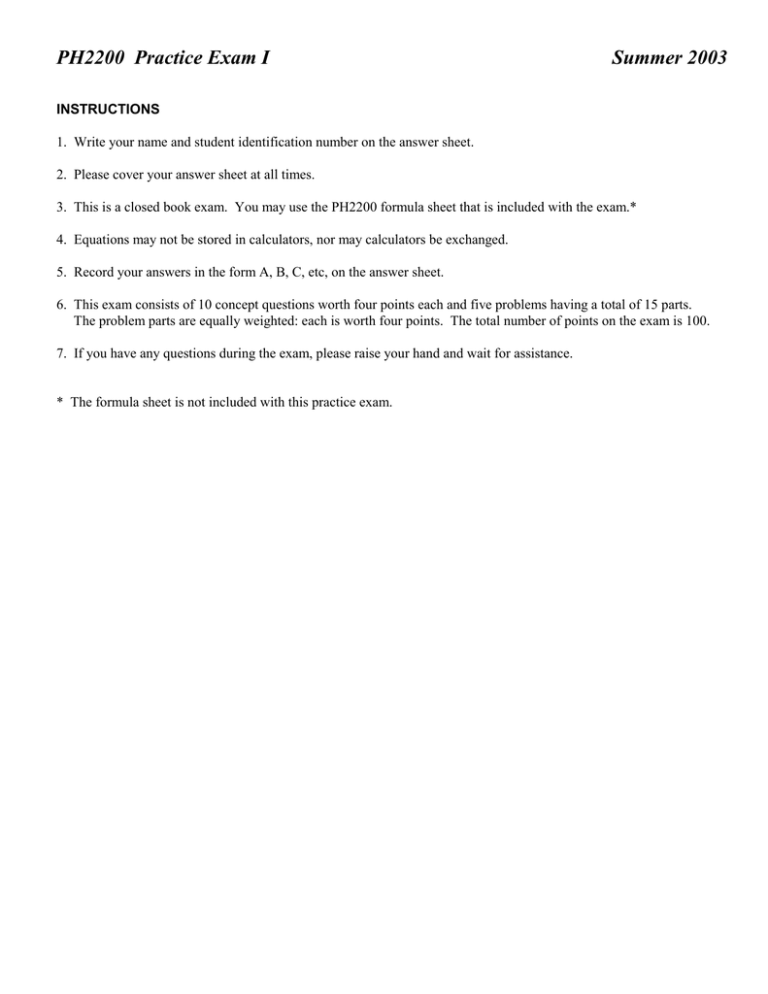
PH2200 Practice Exam I Summer 2003 INSTRUCTIONS 1. Write your name and student identification number on the answer sheet. 2. Please cover your answer sheet at all times. 3. This is a closed book exam. You may use the PH2200 formula sheet that is included with the exam.* 4. Equations may not be stored in calculators, nor may calculators be exchanged. 5. Record your answers in the form A, B, C, etc, on the answer sheet. 6. This exam consists of 10 concept questions worth four points each and five problems having a total of 15 parts. The problem parts are equally weighted: each is worth four points. The total number of points on the exam is 100. 7. If you have any questions during the exam, please raise your hand and wait for assistance. * The formula sheet is not included with this practice exam. PH2200 Practice Exam I Summer 2003 Concept Questions: Each question has a single correct answer and is worth four points. 1. Experimental evidence indicates that (A) (B) (C) (D) (E) charge is quantized and conserved. charge is quantized but not conserved. charge is conserved but not quantized. charge is neither quantized nor conserved. None of the above. 2. Choose the charges Q1 and Q2 that are consistent with the electric field lines shown in the figure to the right. (A) (B) (C) (D) (E) Q1 Q1 = +2 mC, Q2 = +1 mC Q1 = +2 mC, Q2 = -1 mC Q1 = -2 mC, Q2 = +1 mC Q1 = +8 mC, Q2 = +4 mC Q1 = -8 mC, Q2 = +4 mC Q2 3. Point charge Q1 has a charge of +Q and point charge Q2 has a charge of -2Q. In the figures below, the arrows represent the force on each sphere due to the other sphere in that pair. Taking both the direction and the length of the arrows into account, which figure below correctly shows the electric force that each point charge exerts on the other? Q1 Q2 Q1 (A) Q2 Q2 Q1 (B) Q1 (C) Q2 Q1 (D) Q2 (E) 4. Consider a regular cube with positive point charge +Q in all corners except for one which has a negative point charge -Q. Let the distance from any corner to the center of the cube be r. What is the magnitude of electric field at point P, the center of the cube? + + + + •P (A) E = 0 (B) E = 1ke Q / r 2 + (C) E = 2ke Q / r 2 - (D) E = 6keQ / r 2 (E) E = 7 ke Q / r 2 2 + + PH2200 Practice Exam I Summer 2003 5. As shown in the figure to the right, an insulating rod is net into the shape of a semicircle. The left half of the rod has a charge of +Q uniformly distributed along its length, and the right half of the rod has a charge of -Q uniformly distributed along its length. What vector shows the correct direction of the electric field at point P, the center of the semicircle? (A) (B) (C) (D) (E) +Q −Q D A A B C D There is no electric field at point P. • P C B The figure to the right applies to the following two questions. Positive and negative charges of equal magnitude lie along the symmetry axis of a cylinder. The distance from the positive charge to the left end-cap of the cylinder is the same as the distance from the negative charge to the right end-cap. +Q −Q right end-cap 6. What is the flux of the electric field through the closed cylinder? (A) (B) (C) (D) (E) 0 +Q / ε o +2Q / ε o −Q / ε o None of the above. 7. What is the sign of the flux through the right end-cap of the cylinder? (A) positive (B) negative (C) There is no flux through the right end-cap. 8. Which of the following statements is false for a conductor in electrostatic equilibrium? (A) The electric field is zero at all points inside the conductor. (B) Any excess charge resides entirely on the surface. (C) The magnitude of the electric field due to a charged conductor falls off as 1/ r 2 where r is the distance from the conductor to a point in space outside the conductor. (D) The external electric field at the surface of a charged conductor is perpendicular to the surface. (E) The magnitude of the external electric field at a point on the surface of a charged conductor is σ / ε o where σ is the surface charge density at that point. 3 PH2200 Practice Exam I Summer 2003 9. The picture to the right shows the electric field lines between two parallel plates that for all practical purposes extend an infinite distance both to the right and to the left and into and out of the paper. Four points P, Q, R, and S are marked in this picture. At which point is the electric potential the largest? (A) (B) (C) (D) (E) P Q R S The electric potential is the same at all four points. ++++++++++ P Q R S __________ 10. A positive point charge is placed at the center of a hollow conductor that is electrically neutral as shown below. Which figure best represents the electric field lines for this system? + + + (A) (B) (C) + + (D) (E) 4 PH2200 Practice Exam I Summer 2003 Problems: Each part of each problem is worth four points. 1. Consider an electric dipole in a uniform electric field as shown in the figure to the right. The dipole consists of a positive and negative point charge, each having a magnitude of q = 1.60 × 10−19 C , −q and the charges are separated a distance of 5.00 × 10−10 m . +q (a) What is the magnitude of the electric force that one charge of the dipole exerts on the other? (A) (B) (C) (D) (E) 7.65 × 10−10 N 7.97 × 10−10 N 8.24 × 10−10 N 8.86 × 10−10 N 9.20 × 10 −10 N (b) Suppose the dipole is released at rest, oriented as shown in the figure above. Which of the following statements concerning the motion of the dipole is correct, assuming the only force acting on the dipole is the electric force due to the uniform electric field? (A) (B) (C) (D) (E) The center of mass will move, and the dipole will rotate. The center of mass will move, but the dipole will not rotate. The center of mass will remain stationary, but the dipole will rotate. The center of mass will remain stationary, and the dipole will not rotate. None of the above. Now consider an electric dipole in the non-uniform electric field produced by a point charge. As shown in the figure to the right, a point charge of + q = 1.60 × 10−19 C is located at +q the origin with the positive and negative ends of the dipole located at x = 10.0 × 10−10 m and x = 15.0 × 10−10 m , respectively. P +q (c) What is the magnitude of the electric potential at point P located at x = 5.00 × 10−10 m ? (A) (B) (C) (D) (E) 2.13 V 2.76 V 3.01 V 3.98 V 4.31 V (d) What is the magnitude of the net force exerted on the electric dipole by the point charge at the origin? (A) (B) (C) (D) (E) 1.08 × 10−10 N 1.28 × 10−10 N 1.45 × 10−10 N 1.69 × 10−10 N 1.90 × 10−10 N 5 −q x PH2200 Practice Exam I Summer 2003 2. A spherical insulator of radius a is concentric with a conducting spherical shell having inner radius 3a and outer radius 5a as shown in the figure to the right. The charge +Q1 is uniformly distributed throughout the volume of the insulator, and the net charge on the conductor is +Q2 . 3a 5a (a) What is the magnitude of the electric field a distance of 2a from the center of the insulator? a +Q1 (A) 0 (B) Q1 /16πε o a 2 (C) Q1 / 4πε o a 2 (D) Q1 / 2πε o a 2 (E) +Q2 (net) (Q1 + Q2 ) / 4πε o a 2 (b) What is the flux of the electric field through a Gaussian sphere of radius 4a that is concentric with both the insulator and conducting shell? (A) 0 (B) Q1 / ε o (C) (D) (Q1 + Q2 ) / ε o (Q1 + 2Q2 ) / ε o (E) Q1 /16π a 2 (c) What is the surface charge density on the outer surface of the conductor? (A) Q2 /100π a 2 (B) (C) (D) (Q1 + 2Q2 ) /100π a 2 3 (Q1 + Q2 ) /100π a 2 (Q1 + Q2 ) /100π a 2 (E) Q1 − Q2 /100π a 2 6 PH2200 Practice Exam I Summer 2003 3. The visible portion of a lightning strike is preceded by an invisible stage in which a column of electrons extends downward from a cloud to the ground. Assume the linear charge density along the column is −1.15 × 10−3 C/m . Treat the column of charge as if it were straight and infinitely long. (a) What is the flux of the electric field through a closed Gaussian cylinder 1.00 m in length that is coaxial with the column of electrons? (A) (B) (C) (D) (E) −1.05 × 108 N ⋅ m 2 / C −1.15 × 108 N ⋅ m 2 / C −1.30 × 108 N ⋅ m 2 / C −1.47 × 108 N ⋅ m 2 / C −1.68 × 108 N ⋅ m 2 / C λ = −1.15 × 10−3 C/m 1.00 m Gaussian surface (b) At what distance from the column of electrons does the electric field have a magnitude of 3.00 × 106 N/C ? (Air undergoes dielectric breakdown in an electric field exceeding this value, so the distance you calculate is an estimate of the radius of a visible lightning bolt.) (A) (B) (C) (D) (E) 4.17 m 5.55 m 6.89 m 7.34 m 8.01 m 7 PH2200 Practice Exam I Summer 2003 4. Consider a horizontal, insulating plane that is uniformly and negatively charged. Assume the plane is very large so that edge effects may be neglected. The magnitude of the electric field 0.100 m from the plane is 2.50 × 105 N/C . (a) What is the surface charge density of the plane? (A) (B) (C) (D) (E) - - - charged particle parts (c), (d) and (e) −3.16 × 10−6 C/m 2 −3.52 × 10−6 C/m 2 −3.93 × 10 −6 C/m 2 −4.12 × 10−6 C/m 2 −4.43 × 10 −6 C/m 2 (b) What is the magnitude of the electric potential difference between a point 0.100 m from the plane and a point 0.200 m from the plane? (A) (B) (C) (D) (E) 2.50 × 104 V 2.75 × 104 V 3.00 × 10 4 V 3.50 × 10 4 V 4.00 × 104 V (c) A particle of mass 5.35 × 10−6 kg is observed to be at rest 0.100 m below the plane. Gravity acts downward in the figure, and the magnitude of the free-fall acceleration is 9.80 m/s2. What is the charge of the particle? (A) (B) (C) (D) (E) 2.10 × 10−10 C 2.35 × 10−10 C 2.59 × 10−10 C 2.77 × 10−10 C 2.93 × 10 −10 C Suppose that the charged particle acquires a total charge of +7.62 × 10−10 C , and its mass remains the same. (d) What is the direction of the acceleration of the charged particle? (A) up (B) down (C) None of the above. (e) What is the magnitude of the acceleration of the charged particle? (A) (B) (C) (D) (E) 13.0 m/s 2 17.2 m/s 2 20.3 m/s 2 25.8 m/s 2 33.9 m/s 2 8 PH2200 Practice Exam I Summer 2003 5. A continuous line of charge of length 3d lies along the x-axis, extending from x = + d to x = +4d . The line carries a uniform linear charge density λ . y λ x d 3d In terms of d, λ and any necessary physical constants, find the magnitude of the electric field at the origin. (A) (B) (C) (D) (E) λ / 5πε o d λ / 4πε o d 3λ /16πε o d 3λ / 8πε o d λ / 3πε o d 9 PH2200 Practice Exam I Summer 2003 KEY Name: ____________________________________ ID# ___________________________________________ Concept Questions Problems A 1. _______ E 1. (a) _______ E 4. (a) _______ B 2. _______ C (b) _______ A (b) _______ C 3. _______ E (c) _______ A (c) _______ C 4. _______ B (d) _______ A (d) _______ C 5. _______ B 2. (a) _______ D (e) _______ A 6. _______ A (b) _______ C 5. _________ A 7. _______ D (c) _______ C 8. _______ C 3. (a) _______ A 9. _______ C (b) _______ C 10. _______ 10 Subtotal 1 _______ 9 Subtotal 2 _______ 25 Exam Score _______ 10 6 Subtotal 3 _______
